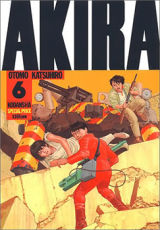Akira is one of the first manga I ever read, and certainly the first to truly impress me so I apologise if this review comes off a little biased.
It goes without saying that Akira is one of the most beautifully drawn comics to grace the medium. Otomo was perhaps the first to incorporate influences from French comics master Jean 'Moebius' Giraud; thus was one of the first manga-ka to introduce a whole new level of realism and cinematic approach to manga creating, that would later be seen in legends such as Masamune Shirow, Jiro Taniguchi, Junji Ito, and more modern artists such as Taiyo Matsumoto and Hiroki Endo.
His pacing is unparalleled, his panel structure and composition fluid and clear. Otomo's rendering of characters is somewhat simple, but ultimately effective and expressive, with a precise understanding of anatomy.
His decision to outline characters with the same size nib pen as his backgrounds is key to the believeability of Neo Tokyo. After a few volumes, the reader becomes so acquainted to the sight of certain buildings and areas, its a little upsetting to see them reduced to rubble later on.
The story is as complex and multi-layered as Neo Tokyo itself. Teenage anarchists, biker gangs, corrupt politicans, devout religious extremists, psychic children, hardy military officials, underground movements, the lot. Amidst this melting-pot of cultures and generations, Otomo never fails to expertly convey the lives of honest, ordinary people (as seen in his earlier short story anthologies) affected by this nightmarish chaos.
In Akira, the character development is fantastic and wholly believable. The tension between childhood friends Tetsuo and Kaneda becomes increasingly more interesting with each volume, as each is confronted by their own personal issues, and the rising differences between them. What's even more intriguing is the problems that arise from this sustained conflict, the unwillingness on the behalf of both characters to face the problem before it escalates.
In Akira, the characters are defined by their actions, and often is the case that central characters will go unnamed for the entire run of the series. Even our first impressions are soon radically altered, and it is the unpredicatability of them that makes Akira so engaging.
I also have to commend Otomo for successfully tackling romance, action, philosophy, religion and morals, and blending them together seemlessly. No relationship ever feels forced; none of the action is overstylized; none of the scientific discussion is poorly-researched.
Akira is perhaps the epitome of what one would call 'epic' storytelling. At six volumes long, with each volumes ranging around 400-600 pages, it's a series that draws you straight in, to a point where you may as well be walking around the alleyways of some run-down lamp-lit section of Neo Tokyo itself.
Nearly thirty-years since Katsuhiro Otomo began drawing it, has Akira become far too dated? Well, the fashion and perhaps aesthetic design may be (although some may dig this retro-futurism, as I do!), but it was a post-modern work back then and certainly is a modern work in today's eyes, and the story still holds up and even betters some of the science-fiction epics of recent years.
Fans of the film will lap this up, and newcomers will find a poweful piece of science-fiction unrivalled in scope and artistic value in Akira.
REQUIRED READING!!!





